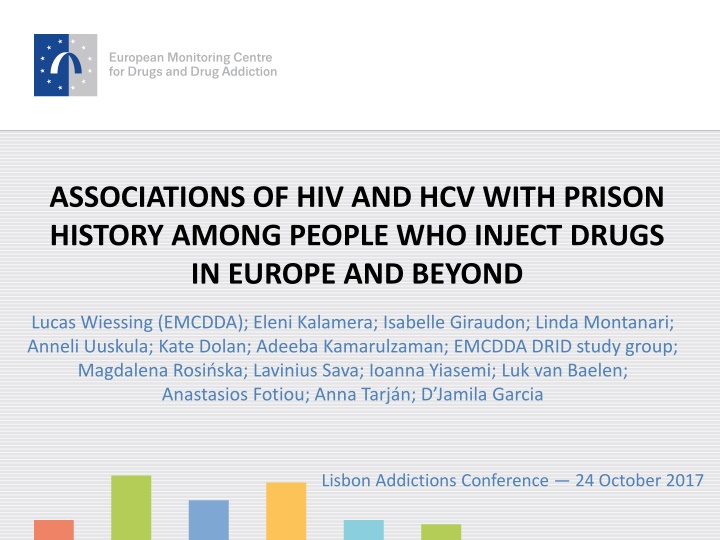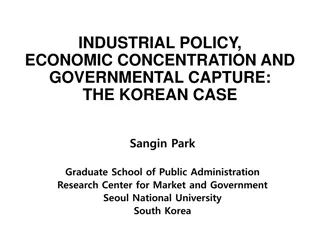
Associations of HIV and HCV with Prison History among People Who Inject Drugs
Explore the link between a history of incarceration and the risk of HIV and HCV infections among individuals who inject drugs in Europe and beyond. Data from EMCDDA, literature reviews, and expert contacts shed light on this critical public health issue.
Download Presentation

Please find below an Image/Link to download the presentation.
The content on the website is provided AS IS for your information and personal use only. It may not be sold, licensed, or shared on other websites without obtaining consent from the author. If you encounter any issues during the download, it is possible that the publisher has removed the file from their server.
You are allowed to download the files provided on this website for personal or commercial use, subject to the condition that they are used lawfully. All files are the property of their respective owners.
The content on the website is provided AS IS for your information and personal use only. It may not be sold, licensed, or shared on other websites without obtaining consent from the author.
E N D
Presentation Transcript
ASSOCIATIONS OF HIV AND HCV WITH PRISON HISTORY AMONG PEOPLE WHO INJECT DRUGS IN EUROPE AND BEYOND Lucas Wiessing (EMCDDA); Eleni Kalamera; Isabelle Giraudon; Linda Montanari; Anneli Uuskula; Kate Dolan; Adeeba Kamarulzaman; EMCDDA DRID study group; Magdalena Rosi ska; Lavinius Sava; Ioanna Yiasemi; Luk van Baelen; Anastasios Fotiou; Anna Tarj n; D Jamila Garcia Lisbon Addictions Conference 24 October 2017
Disclosures No conflicts of interest reported: Lucas Wiessing none; Eleni Kalamera none; Isabelle Giraudon none; Linda Montanari none; Anneli Uuskula none; Kate Dolan none; Adeeba Kamarulzaman none; EMCDDA DRID study group; Magdalena Rosi ska none; Lavinius Sava none; Ioanna Yiasemi none; Luk van Baelen none; Anastasios Fotiou none; Anna Tarj n none; Anda Kivite none; Ruth Zimmermann none; D Jamila Garcia none
Background People who inject drugs (PWID) are frequently incarcerated due to punitive drug laws A history of incarceration is associated with elevated risks of drug-related problems including high HIV and HCV prevalence and other outcomes (overdose, injecting risk)
Aims 1. To evaluate the association between a history of incarceration and risk of HIV and HCV infection among PWID in Europe (EMCDDA data) 2. To put results in context of available data from other sources
Methods 1. Aggregate data from EMCDDA monitoring among PWID in 30 countries (EU+2), univariate odds ratio s for HIV and HCV 2. Individual level data from a European collaboration of studies in PWID, adjusted odds ratio s in meta- analysis for HIV, five countries 3. Ad hoc literature review and contact with key experts for examples from inside and outside Europe (Australia, Canada), for HIV, HCV, mortality and syringe sharing
1. EMCDDA routine aggregated monitoring data, univariate odds ratio s
Results 17 out of 30 countries provided aggregated HIV and/or HCV prevalence data among PWID for 2006-2015, by prison history (ever, never) For HIV: total n=42479 PWID, ever in prison 27581, of whom HIV+ 1713 (6.2%); never in prison 14898 of whom HIV+ 934 (6.2%) OR 0.99 (95%CI 0.91-1.07) For HCV: total n=38956 PWID, ever in prison 25431, of whom HCV+ 14159, (55.7%); never in prison 13525 of whom HCV+ 5333 (39.4%) OR 1.93 (95%CI 1.9-2.1) Among PWID ever in prison, HIV prevalence (0.3 to 64%, median 6.7%) and HCV prevalence (8 to 96%, median 68.5%) varied strongly between countries
Recruitment settings Drug treatment centres (DTC) Needle and syringe programmes (NPS) /low threshold services (LTS) 4 countries Combined DTC + NSP/LTS Combined NSP/LTS + not service based (street /RDS) Not service based (street /RDS) 5 countries 4 countries 2 countries 2 countries RDS: respondent driven sampling
2 8 5 3 6 1 5 1 8 2 0 7 1 1 1 2 4
Association between prior prison history and HIV infection among PWID in Europe, 2006-2015
Association between prior prison history and HCV infection among PWID in Europe, 2006-2015 Slovakia excluded for small n (n=58, OR=1.58, 95%CI 0.5-5.4)
Limitations Studies are not always comparable between countries (recruitment in treatment, low-threshold services, respondent driven sampling etc. however: same association seen in a number of countries and across two diseases) Self-reported prison history may be concealed (however: that is likely to reduce associations) About half of the 30 EMCDDA collaborating countries (EU+2) do not report data by prison history No possibility to adjust odds ratio s for potential confounders in multivariate analysis e.g. age (however: these data should serve as a warning sign, to be further studied) The cross-sectional nature of the data does not allow inferences about causality Part of the HIV data, in two countries, concern self-reported test results
2. Individual data from a European collaboration of studies in PWID, adjusted odds ratio s in meta- analysis for HIV, five countries
Association of prison history and HIV: meta-analysis of 9 PWID studies in West and Eastern Europe (Uuskula et al., in preparation) AOR - adjusted for gender, age, duration of injecting
3. Context from the literature on similar associations for HIV, HCV and other outcomes
Associations of prison history and HIV, and HCV among PWID in Greece, Spain, Canada, Australia Greece: Fotiou et al. (Hepatology, Medicine and Policy, 2016), found similar results in multivariate analysis for PWID entering OST : prison history = 2 to 3 higher risk of HCV infection (regardless HIV infection status), national level 2013 data n=580 Athens: Sypsa et al, (JID 2017); Hatzakis et al, (Addiction 2015): 3320 PWID recruited through a high coverage community-based programme in Athens 2012-2013: 40% ( ) to 50% ( ) ever imprisoned / 11% ( ) to 20% ( ) in last 12 months Prison ever vs never for HIV infection: Prevalence in Males : Prevalence in Females : Seroconversion: OR = 1.66 (95%CI 1.34 2.06) OR = 3.09 (95%CI 1.90 5.03) OR = 2.40 (95%CI 1.27 4.53) Spain: Canada: HIV vs ever in prison (prevalence ratio = 2.03) (Folch, PMID 26820260) Imprisonment associated with syringe sharing / sex risk p<0.05 HCV prevalence 13-22% higher for prison history (Chow, ISSN 1448-5915) (Werb, PMID 18387974) Australia:
Other health outcomes associated with prison history? Global review: mortality Released prisoners are at increased risk for death following release from prison, particularly in the early period. (Zlodre, PMCID: PMC3519300) Global review: structural sexual /injecting risks in female prisoners Repeated cycles of arrest, incarceration, and release can be socially and economically destabilizing for women, exacerbating their HIV risk. (Strathdee, PMID: 25978477) Canada: syringe sharing and sexual risks Incarceration was independently associated with risky needle sharing [after release] for HIV-infected and HIV-negative IDUs. (Wood, PMCID: PMC1497693)
Interventions in prisons to prevent infectious diseases in Europe (EU+2), 2016 Source: EMCDDA 2017 Health and Social Reponses to drug problems. A European Guide 21
Interventions around release from prison (through-care) for drug users in Europe number of countries reporting out of 30 (EU+2)
Coverage of opioid substitution treatment (percentage of estimated high-risk opioid users receiving the intervention) EMCDDA 2017
Coverage of specialised syringe programmes: number of syringes provided per estimated injecting drug user EMCDDA 2017
Conclusions Strong associations exist between both HIV and HCV prevalence and prison history among PWID in Europe There is a need to improve interventions to stop prison associated transmission, both in prison and/or after release This includes offering in prisons: screening, referral, DAA for HCV or HIV treatment, together with prevention and harm reduction and through-care on release/transfer This also includes attaining full coverage and quality of harm reduction and treatment for PWID in the community Globally, large gaps in care and treatment for drug dependence and associated problems like HIV and HCV infection still exist in prisons, as well as in the community /post release (PMID:27427456 + ISBN:978-0-9935434-3-2)
Lancet 2016 global HIV in prisons review Recommendations Decriminalise minor drug offences use, possession, and petty sale Reduce the violence and other harms of drug policing Make harm reduction measures a central pillar of health systems and drug policy Invest in treatment for HIV, HCV infection, tuberculosis, and drug dependence Ensure access to controlled drugs for medical use
Thank you for your attention Lucas.Wiessing@emcdda.europa.eu Acknowledgements DRID study group: nominated Drug-related infectious diseases national experts and the Reitox national focal points from the EU 28, Norway and Turkey, for annual reporting of the data to the EMCDDA
HIV prevalence (%) among people who have injected drugs less than 2 years, 2006-2015
HCV antibody prevalence (%) among people who have injected drugs less than 2 years, 2006-2015




















